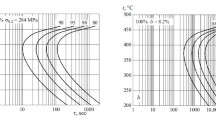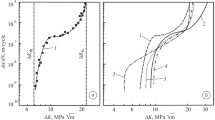Summary
-
1.
Thermocyclic aging of EI437 type alloys produces on the surface the same hardness as in ordinary aging, but in a very much shorter time.
-
2.
In thermocyclic aging only the surface is hardened, the core remaining only partially aged. Hence as a rule,the strength of such specimens is lower than after ordinary heat treatment.
-
3.
The rupture strength of thermocyclically aged EI437 is in many cases below the rupture strength obtained by ordinary aging.
-
4.
Thermocyclic aging can only be used when components made from an aged alloy need to have high surface strength with a fairly tough core.
Similar content being viewed by others
References
A. A. Bochvar, Fundamentals of Heat Treatment of Alloys, ONTI, 1931.
S. T. Konobeevski, Zhur. Eksper. Teor. Fiz., vol. 13, 1943, (6).
A. A. Bochvar, Izv. Akad. Nauk SSSR, Otd. Tekh. Nauk, 1948, (5), 649–653.
I. A. Oding, Ibid., 1949, (12), 1774–1783.
V. I. Prosvirin, Vestnik Mashinostroenie, vol. 33, 1953, (1), 42–47.
L. N. Aleksandrov and V. Ya. Lyubov, Dokl. Akad. Nauk SSSR, vol. 83, 1952, (6), 833–835.
M. I. Zakharova and N. F. Lashko, Izv. Akad. Nauk SSSR, Otd. Tekh. Nauk, July 1946, (7), 1015–24.
N. I. Blok et al., Zav. Lab., vol. 20, 1954 (8).
Rights and permissions
About this article
Cite this article
Ermakov, V.S. Cyclic aging of high temperature alloys of the [Nickel-base] EI437 type. Met Sci Heat Treat 1, 17–22 (1959). https://doi.org/10.1007/BF00820269
Issue Date:
DOI: https://doi.org/10.1007/BF00820269




